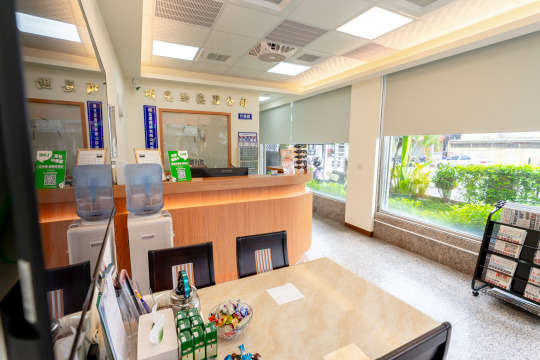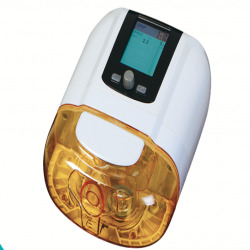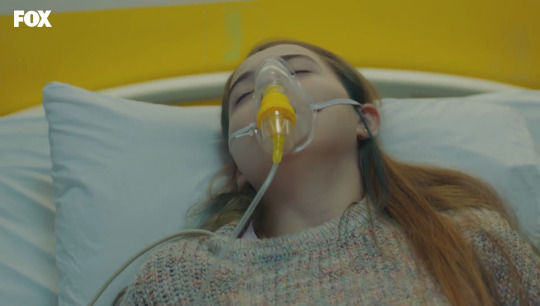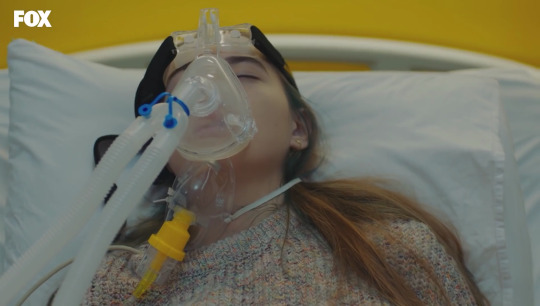#bipap
Text
#tiktok#fda#cpap machine#cpap therapy#cpap#sleep apnea#fda recall#recall#sleep aid#bipap machine#bipap#psa
5 notes
·
View notes
Note
how important is cpap maintenance? I struggle with it now and want to know if I should invest effort into actually changing the filters or putting water in the humidifier will help my sleep or if it's mostly okay and would only bring marginal benefits
When I was briefed on mine, I was assured that it's very important to keep it clean. You don't want to be breathing in dust and mildew after all. The thing that prompted me to make that post last night was that I'd changed out the filter two weeks late and breathing felt SO much easier and nicer. (I did uhhh use a cut out bit of an n95 mask because I haven't gotten around to ordering more filters, but honestly I think this works just fine, maybe better. And it's cheaper so I might keep doing it.) It was a relief and I slept pretty well last night.
I'm not a professional in any sense so take this as a limited experience opinion, but I'd also say putting water in the humidifier is probably important, unless it's very humid where you are. I forgot once and woke up with a horribly dry throat and it was awful compared to when I don't forget. :c Also rinsing it out is important because mildew and other build-up; another point in time I'd just left it for a while (it was super humid out and the water wasn't even going down each night) and when I opened it up again to rinse out, it smelled... weird. And I felt better after cleaning it out.
In general, I think it's important to make sure you're not breathing in particles that could hurt your health all night long.
I just dug out the maintenance guide I was given when I got mine. I don't rinse the tubing every day anymore (the doctor I spoke to said the once a week cleaning was fine enough), but it's a good guide and maybe it'll help you too? For reference, this is directed toward people with ResMed PAPs.


(The ratio it mentions is 1 part distilled white vinegar to 1 part
hot water.)
8 notes
·
View notes
Text
If you use a CPAP or BiPAP and use chapstick:
Do not use a chapstick with petroleum-based products in it — it will degrade your masks
#cpap#bipap#osa#sleep apnea#i struggled to find one but bert's bees coconut & pear doesn't#many bert's bees products contain petroleum products so be mindful#and look ingredients up :/#it's a pain in the ass but the masks are expensive
11 notes
·
View notes
Text
Affordable BiPAP Machine Rentals in Delhi | LG Respicare
Looking for BiPAP machine rentals in Delhi? LG Resp-iCare offers top-quality BiPAP machines for rent at affordable prices. Our extensive range of BiPAP machines ensures that you find the perfect fit for your respiratory needs. Whether you require short-term or long-term rental options, we've got you covered. Our machines are meticulously maintained and sanitized to ensure optimal performance and hygiene. With easy rental procedures and excellent customer service, renting a BiPAP machine has never been easier. Trust LG Respicare for reliable, affordable, and hassle-free BiPAP machine rentals in Delhi. Visit our website to explore our offerings today!
1 note
·
View note
Text
潮州門市慶開幕|『耳聲新世界,享受聽力新生活』🎉
【潮州唯一助聽器公司】
聽見的人有福了!!不用再跑屏東市或高雄
醫院等級的聽力室
專業聽力檢查設備
經驗豐富的選配師
助聽器活動超優惠

3月5日(二)潮州門市正式開幕!
我們非常高興地宣布,頌恩再次擴展開設潮州門市!為屏東鄉親提供更多的聽力照護方案及關懷!
我們準備3月全門市愛耳日優惠以及4月潮州門市專屬開幕優惠。活動期間多樣助聽器、呼吸器超值折扣!除此之外,只要新客預約來店聽力檢查達到25分貝再送限量精美小禮物,帶給您最滿意的服務,為更清晰的聆聽創造更多可能性。

潮州開幕優惠
Audio Service G6/G7 雙世代優惠
Danavox gn Klar 系列優惠
陽壓呼吸器優惠
新客來店聽力檢查,達到指定條件即送精美小禮物!!

門市資訊
🏠 潮州鎮三共里延平路92號(中正市場附近)
👂line:@578mncay
☎️ 電話 0877896015
0 notes
Text
Hospital bed on rent in delhi
We PHhealthcares Delhi NCR Based Company Induced In The Year 2015, PHhealthcares Is A Highly Recognized Company Of The Industry Involve Sale & Rental Services Of Medical Equipment Like Oxygen Concentrator (Machine) , Cpap , Bipap ,Face Mask , Patient Monitor ,Oxygen Cylinder ,WheelChair And Sleep Study Test(Polysomnography Test) & Many . Our Provided Products Are Optimal & Highly Trustable . Our Products Are Highly Demanded By Costumer For Our Best Quality & Longer Services . We Have A Team Of Skilled Qualified To Handle Our Costumers. We Provide Cost Effective & Complete Medical Solutions For Patients And Provide Latest Technology For Patients With Hands On Learning For Them.
for more info visit : https://oxygenconcentratorindelhi.com/
contact us
Address- House No, 664 C Nyay Khand 1 Indra Puram, Near Sai Mandir, Ghaziabad Uttar Pradesh, pin code 201014
Mobile no. 9210069770
8368886992
1 note
·
View note
Text
#Bipap Machine#bipap#bipoc#Bipap#machine#cpap machine#hospitals#hospital#doctors#healthcare#medical care#my sewing#disease#patient
0 notes
Text
Medical CPAP System
Medical CPAP System CPAP-1000A; Work mode=cpap-synch; CPAP=pressure-range-4-cmh-lt-sub-gt-2-lt-sub-gt-o-20-cmh-lt-sub-gt-2-lt-sub-gt-o; Backup rate=; Pressure delay rise time=0-min-60-min; I/E=;Shop Online at Medzer.com

0 notes
Text
World Sight Day
On World Sight Day, MediKart HealthCare Systems proudly stands as your guiding light towards a brighter future for all. With our healthcare products, we illuminate the path to better vision and improved well-being. Together, let's envision a world where everyone sees a healthier tomorrow.

#medikarthealthcare#vision#improvedhealth#worldsightday#wellness#healthierchoices#cpap#bipap#oxygenconcentrator#healthcare#medikart#system
0 notes
Text
The Key Considerations for Choosing the Right Hospital Equipment
Introduction
Hospital equipment is the backbone of patient care, diagnostics, and treatment. However, selecting the right equipment can be a daunting task for hospitals and doctors. With a wide range of options available in the market, it's crucial to consider key factors that address the specific needs and challenges faced by medical professionals. In this article, we will explore the key considerations when choosing hospital equipment, focusing on the keywords "BMC BiPAP machine," "ECG machine," and "Ventmed BiPAP." By understanding these factors, hospitals and doctors can make informed decisions that enhance patient care and streamline operations.
Addressing the Challenges of Choosing the Right Hospital Equipment
Hospitals and doctors face several challenges when selecting the appropriate equipment for their facilities. These challenges include:
Finding the optimal respiratory support equipment: With the increasing demand for respiratory support in healthcare, hospitals and doctors often struggle to choose the right BiPAP machine, such as the BMC BiPAP machine or Ventmed BiPAP, that meets their patients' unique needs.
Ensuring accurate diagnostics and monitoring: Medical professionals require reliable ECG machines that deliver accurate results for precise diagnostics and monitoring. The challenge lies in finding an ECG machine that combines functionality, quality, and affordability.
Functionality and Performance
Choosing hospital equipment with the right functionality is crucial for accurate diagnostics, treatment, and patient monitoring. When evaluating equipment options such as the BMC BiPAP machine, ECG machine, or Ventmed BiPAP, consider the following:
Advanced features and capabilities: Assess the equipment's functionalities and determine if they align with the specific clinical requirements of your facility.
Ease of use and intuitive interfaces: Ensure the equipment is user-friendly and can be efficiently operated by medical professionals.
Compatibility with other systems: Verify if the equipment integrates smoothly with existing systems, allowing for seamless data transfer and sharing.


Quality and Reliability
The quality and reliability of hospital equipment significantly impact patient care and long-term performance. When evaluating options like the BMC BiPAP machine, ECG machine, or Ventmed BiPAP, consider:
Manufacturer reputation: Choose equipment from reputable manufacturers known for their commitment to quality and compliance with industry standards.
Certifications and compliance: Check if the equipment meets relevant certifications and regulatory requirements to ensure patient safety and adherence to standards.
Durability and longevity: Opt for equipment made from high-quality materials and construction to ensure reliable performance and longevity.
Compatibility and Integration
Hospital equipment should seamlessly integrate with existing systems and workflows to optimize efficiency. Consider the following:
Compatibility with IT infrastructure: Ensure the equipment can be integrated with electronic health record systems (EHRs) or hospital information systems (HIS) for efficient data management and streamlined workflows.
Interoperability with other equipment: Verify if the equipment can communicate and exchange data with other devices, enabling comprehensive patient care and interoperability.
Standardized reporting and interfaces: Choose equipment that generates standardized reports and interfaces, simplifying data interpretation and integration with other systems.
Pricing and Value
Pricing is a critical consideration when selecting hospital equipment. It's important to find a balance between affordability and long-term value. Consider the following:
Total cost of ownership: Evaluate the total cost over the equipment's lifespan, including maintenance, operational expenses, and potential upgrades.
Value proposition: Assess the equipment's value in terms of improved patient outcomes, enhanced efficiency, and return on investment.
Financing options: Explore leasing or financing options that can help manage upfront costs and align with budget constraints.
After-Sales Support and Service
Comprehensive after-sales support ensures the smooth operation and maintenance of hospital equipment. When evaluating options, consider:
Warranty and service agreements: Check the warranty period and the availability of service contracts that cover maintenance and repairs.
Technical support and training: Ensure the manufacturer or supplier offers reliable technical support and training for medical professionals to effectively operate the equipment.
Spare parts availability: Verify the availability of spare parts to minimize downtime in case of equipment failures or repairs.
Conclusion
By addressing these key considerations, hospitals and doctors can make well-informed decisions that optimize patient care, streamline operations, and enhance overall efficiency. For a wide range of hospital equipment solutions, visit tentabs.com to explore our offerings and find the equipment that meets your specific needs.
0 notes
Text
Oxygen Cylinders: Enhancing Respiratory Function and Quality of Life
Introduction:
Oxygen cylinders play a crucial role in providing life-saving oxygen therapy to individuals with respiratory conditions. This article delves into the different types of oxygen cylinders available, highlights their importance in healthcare settings, explores their benefits, and addresses potential drawbacks associated with their usage.
Types of Oxygen Cylinders:
1. Compressed Gas Oxygen Cylinders: These cylinders store oxygen in compressed form, typically at high pressure. They are commonly used in hospitals, clinics, and emergency medical services.
2. Liquid Oxygen Systems: Liquid oxygen is stored in specially designed containers that keep it in a liquid state. This type of system is often used for patients who require long-term oxygen therapy at home.
The different sizes of Oxygen Cylinder:
Oxygen cylinders come in various sizes to meet the diverse needs of patients requiring oxygen therapy. Here are some common oxygen cylinder sizes:
B Cylinder: The B cylinder is a commonly used size for home oxygen therapy. It holds approximately 160 liters of oxygen and provides an extended oxygen supply, suitable for patients requiring portable oxygen therapy.
D Cylinder: The D cylinder is commonly used for home oxygen therapy. It holds about 425 liters of oxygen and offers a more extended oxygen supply compared to smaller cylinders. Its size makes it relatively portable for patients needing oxygen on the go.
E Cylinder: The E cylinder is larger than the D cylinder and can hold approximately 680 liters of oxygen. It is often used in healthcare facilities, ambulances, and home care settings where patients require a moderate amount of oxygen for an extended period.
M Cylinder: The M cylinder is significantly larger and holds approximately 3,000 liters of oxygen. It is commonly used in hospitals, clinics, and other healthcare settings where patients require a substantial oxygen supply.
H/K Cylinder: These are the largest oxygen cylinders available, primarily used in healthcare facilities. They can hold up to 6,900 liters of oxygen and are used for patients requiring high-flow oxygen therapy for an extended duration.
Importance of Oxygen Cylinders:
Oxygen cylinders are vital for patients suffering from respiratory conditions such as chronic obstructive pulmonary disease (COPD), pneumonia, asthma, and other lung disorders. These cylinders provide supplemental oxygen to help improve oxygen levels in the bloodstream, thereby reducing breathlessness, fatigue, and other symptoms associated with inadequate oxygenation. Oxygen therapy can enhance patients' quality of life, promote faster recovery, and even save lives during critical situations.
Oxygen Cylinder used for Oxygen therapy:
Oxygen cylinders play a critical role in oxygen therapy, which involves the administration of supplemental oxygen to individuals with respiratory conditions. Here are several reasons why oxygen cylinders are important for oxygen therapy:
Increased Oxygen Levels: Oxygen therapy aims to increase the oxygen levels in the bloodstream, ensuring an adequate supply to the body's organs and tissues. Oxygen cylinders provide a concentrated source of oxygen that can be delivered directly to the patient, effectively raising oxygen levels and improving overall oxygenation.
Improved Quality of Life: Insufficient oxygen levels can significantly impact a person's quality of life. Oxygen therapy through cylinders can alleviate symptoms such as shortness of breath, fatigue, and dizziness, allowing patients to engage in daily activities with greater comfort and ease. By improving their ability to perform routine tasks, oxygen therapy enhances the overall well-being and independence of individuals with respiratory conditions.
Emergency Situations: Oxygen cylinders are indispensable during medical emergencies, such as cardiac arrest, trauma, or respiratory failure. In critical situations where immediate access to oxygen is crucial, oxygen cylinders can be a lifesaving resource. They provide a readily available supply of oxygen until further medical interventions or assistance can be provided.
Benefits of Oxygen Cylinders:
1. Enhanced Respiratory Function: Oxygen cylinders provide an immediate and reliable source of supplemental oxygen, improving the respiratory function of patients with compromised lung capacity. This helps alleviate symptoms, boost energy levels, and enhance overall well-being.
2. Improved Physical Endurance: By increasing the oxygen supply to the body, oxygen cylinders enable individuals to engage in physical activities that would otherwise be challenging. This enhanced endurance promotes mobility, independence, and a more active lifestyle.
3. Customizable Treatment: Oxygen cylinders allow for adjustable flow rates, enabling healthcare professionals to tailor treatment plans to individual patient needs. This flexibility ensures optimal oxygen delivery, maintaining a balance between effectiveness and safety.
Drawbacks of Oxygen Cylinders:
1. Limited Portability: Oxygen cylinders can be heavy and cumbersome, making them challenging to carry for extended periods. This limitation restricts mobility and may hinder patients' ability to engage in certain activities outside their homes.
2. Dependency on Supply: Patients relying on oxygen cylinders must ensure a continuous and adequate supply. This can be challenging, especially in remote areas or during natural disasters or other emergencies when supply chains may be disrupted.
3. Safety Considerations: Oxygen cylinders should be handled with care due to their flammability. Smoking, open flames, or improper storage can pose a significant fire hazard. Proper training and adherence to safety guidelines are essential for both patients and caregivers.
Conclusion:
Oxygen cylinders are indispensable medical devices that provide vital oxygen therapy to individuals with respiratory conditions. Despite certain drawbacks, their importance in improving respiratory function, enhancing physical endurance, and ensuring emergency oxygen supply cannot be overstated. With proper usage and maintenance, oxygen cylinders contribute significantly to patients' well-being and quality of life. Patients should consult with their healthcare providers to determine the appropriate cylinder size based on their specific oxygen therapy needs. They determine the appropriate oxygen delivery method, flow rate, and duration of therapy based on the patient's condition, oxygen saturation levels, and specific medical needs. Proper and responsible use of oxygen cylinders ensures the effectiveness and safety of oxygen therapy for patients requiring supplemental oxygen.
About F7 Healthcare Pvt. Ltd.
F7 Healthcare Pvt. Ltd. is a dedicated company that supplies equipment to patients, healthcare companies and manufacturing industries. We provide Oxygen Cylinders in Hyderabad for rent or sale at affordable price. We ensure that our customers receive the best supplies and services since we acknowledge the significance of effective oxygen therapy. If you are looking to purchase Oxygen cylinder in Hyderabad, our expert team can help you choose the suitable Oxygen Cylinder for rent or sale. Visit our website www.f7healthcare.com to get in touch with us for more information.
1 note
·
View note
Text

https://cg24.org/home-nursing-services-in-bihar.html
BIPAP MACHINE ON RENT IN PATNA
CAREGIVERS24
CAREGIVERS24 is now offering BiPAP machine rental in Patna. The organization provides individuals with access to high-quality BiPAP machines on a rental basis, making it easier and more affordable for individuals to access this vital medical equipment.
0 notes
Text
Non-invasive Ventilation: An Overview of Respiratory Support
Non-invasive Ventilation: Introduction
Non-invasive Ventilation
Non-invasive ventilation (NIV) is a treatment option for persons with respiratory failure that improves oxygenation and decreases carbon dioxide levels without requiring intubation. NIV can be provided in a variety of ways, including BiPAP (bilevel positive airway pressure) and noninvasive positive pressure ventilation (NIPPV),…

View On WordPress
0 notes








